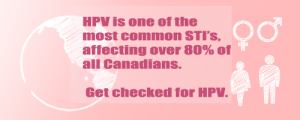Facts About HPV
HPV or Human Papilloma Virus is described as an accumulation of viruses found in both men and women.
Most people get HPV through sexual contact; this also means manual or oral contact. There are often no symptoms and people don’t know they have the virus. HPV can stay within the body for many years and cause cell changes in the cervix which can be found in a PAP smear. The change is called dysplasia and this can go away without treatment. Only some types develop into cancer. It’s important to have regular check ups to make sure the dysplasia is not getting worse. There are some things that increase your chance of dysplasia which include smoking, sexual intercourse at an early age, multiple sex partners, and sexually transmitted diseases.
During your visit, your cervix or vulva will be sprayed with vinegar to make any abnormal areas look white. If areas show up, they may do a biopsy. The examination doesn’t take too long at all, within 10 minutes you will be able to leave.
About 90% of genital warts (condylomata acuminata) are caused by low-risk HPV-6 and HPV-11. Genital warts do not turn into cancer.
Two Types of HPV
Low risk and high risk
The most common low-risk types are HPV-6 and HPV-11, although there are others.
HPV-6 and HPV-11 can also cause an uncommon condition called recurrent respiratory (laryngeal) papillomatosis. This condition causes benign tumours to grow inside the larynx or the respiratory tract.
About 13 high-risk types of HPV cause cancer. There is sufficient evidence that HPV-16, HPV-18, HPV-31, HPV-33, HPV-35, HPV-39, HPV-45, HPV-51, HPV-52, HPV-56, HPV-58 and HPV-59 cause cancer. HPV-68 probably causes cancer.
HPV-16 and HPV-18 are the most common high-risk types.
Persistent infection with high-risk HPV types can cause cell abnormalities. If these abnormalities are left undetected and untreated, they can develop into cancer.

Exposure to HPV
HPV is the most common sexually transmitted infection. You can get it through oral sex, it can infect the penis, vulva, vagina, cervix, rectum, anus and throat. Certain types of sexual behaviour increase a person’s risk of HPV infection, such as having many sexual partners and having unprotected sex. People with a weakened immune system immune system are more susceptible to HPV.
It’s hard to know who you got it from because it comes and goes, without any signs or symptoms. Wearing a condom will not prevent you from contracting HPV. It can reduce the risk but areas not covered are still at risk. Because of this, 80% of all Canadians have been exposed to HPV.
[content-egg module=Amazon]
HPV Symptoms
Most people don’t know they have it because many types don’t have any symptoms. This makes it easy to pass along.
Some cause genital warts. The warts may look like a cauliflower, but some are too small to be seen.
HPV and Cancer
HPV-16 and HPV-18 (31, 33, 35 etc.) cause about 70% of cervical cancers, including other cancers anywhere near the vaginal or anal area.
70% of infections clear up on their own within 1-2 years. Stubborn strains can lead to precancerous changes and cancer. This doesn’t mean everyone exposed will get cancer, only a few lead to more serious side effects.

Testing for HPV
Very similar to a PAP smear but the HPV test looks at DNA to pinpoint the strain. In Canada it’s called a Colposcopy, in which a microscope is used to look into your cervix. During this examination, they may take a biopsy if something is seen as irregular. The vagina is also strayed with vinegar to highlight anything unusual.
Once HPV testing is needed, you will no longer see your regular doctor for PAP smears until you are cleared by the hospital as virus free. Women 30 and over are more susceptible to the virus and are more likely to be screen for cervical cancer.
the infections in women 30 and under are less likely to last as long and are more likely to dissipate on their own.
HPV does cause cervical cancer but it not part of screen programs, even though HPV DNA is found in almost all cervical cancers. Studies are currently being done to rectify this.
HPV Testing in Men
As of now, there are no approved test of HPV DNA testing in Canada for men, but warts associated with HPV can be seen by a health care professional.
HPV Treatment
If the problem is mild, you might not need to be treated. Regular check up may only be needed until you can be discharged from the clinic.
Treatment is not done on your first visit. Once your results come back, it till be determined if treatment is needed. There are several procedures that can be done, including Loop Excision, Laser Therapy, Cryo Therapy, Cone Biopsy and Hysterectomy. Listed from less sever to very sever, the last being a surgery to remove your uterus. This is an extremely rare treatment and is only done if there are other gynaecological problems.
Sites to look into:
